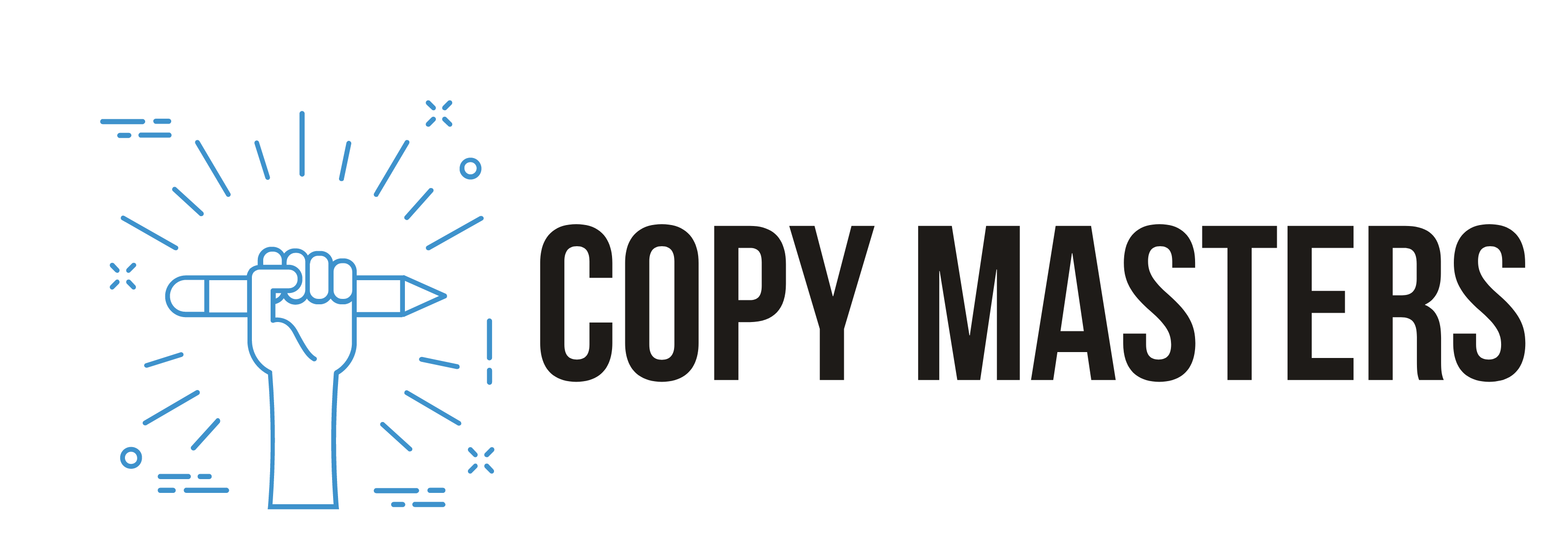In the competitive digital landscape, driving traffic to your website is only half the battle. The real challenge, and the greatest opportunity, lies in turning those visitors into loyal customers. This is where Conversion Rate Optimization (CRO) becomes your most valuable asset. It’s the science and art of enhancing your website to maximize the percentage of visitors who complete a desired action, whether it's making a purchase, signing up for a newsletter, or filling out a form.
Generic advice won't cut it anymore. To achieve meaningful growth, you need specific, data-backed strategies that address every stage of the user journey. This guide moves beyond the basics, offering a curated roundup of high-impact conversion rate optimization tips that you can implement today. We will cover everything from the technical nuances of page speed and the strategic placement of trust signals to the psychological power of a compelling call-to-action. To truly unlock your website's potential and effectively convert visitors, implementing sophisticated tools like lead generation chatbots can dramatically improve your ability to qualify prospects and drive conversions.
From refining your value proposition with benefit-focused copy to streamlining the final click at checkout, each of the eight tips in this article is designed to deliver measurable results. By the end, you'll have a clear roadmap to stop leaving money on the table and start turning your website into a powerful, efficient conversion engine. Let's dive into the actionable tactics that will transform your clicks into customers.
1. A/B Testing and Multivariate Testing
A/B testing, also known as split testing, is a methodical approach to comparing two versions of a webpage, email, or app against each other to determine which one performs better. By presenting version A (the control) and version B (the variation) to similar visitor segments simultaneously, you can collect empirical data on which one more effectively achieves your conversion goal. This process removes guesswork and gut feelings from the optimization process, allowing for data-driven decisions that generate incremental, yet powerful, improvements over time.
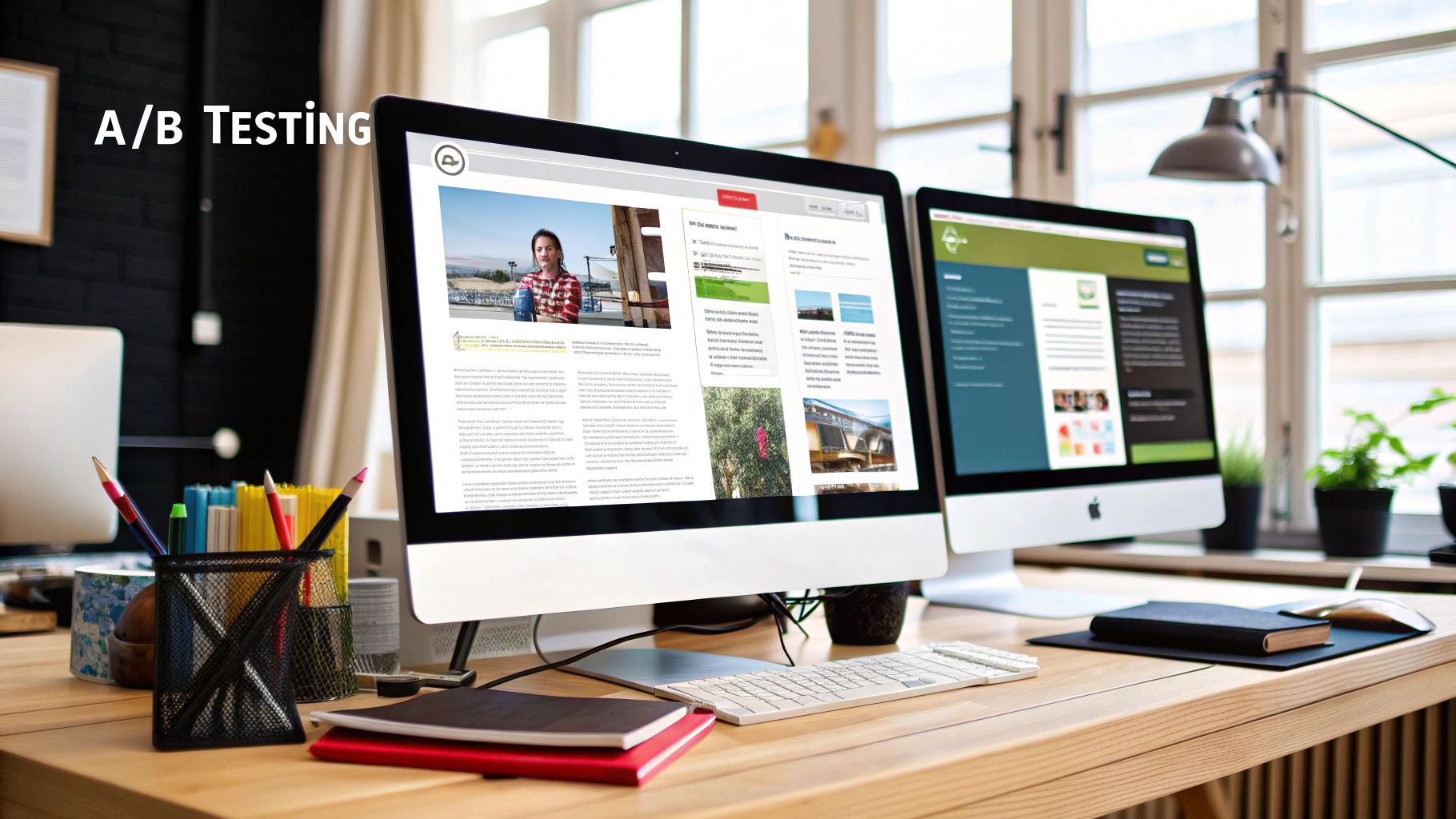
Multivariate testing takes this concept a step further by testing multiple variables on a single page at the same time. While a standard A/B test might compare two different headlines, a multivariate test could simultaneously test several headlines, call-to-action buttons, and images to identify the winning combination. This is one of the most fundamental conversion rate optimization tips because it provides a clear, scientific framework for improvement.
How to Implement Effective Testing
Successful testing requires a structured approach. It’s not just about randomly changing elements; it’s about making calculated adjustments based on a clear hypothesis. For instance, a hypothesis could be: "Changing the CTA button text from 'Submit' to 'Get My Free Guide' will increase form submissions because it more clearly communicates the value."
Key steps to follow:
- Establish a Baseline: Analyze your current conversion rate to have a benchmark for comparison.
- Formulate a Hypothesis: Based on user data or analytics, identify a potential area for improvement and create a testable hypothesis. What do you think will work better, and why?
- Create Variations: Build the new version(s) of your page or element using A/B testing software like Optimizely, VWO, or Google Optimize.
- Run the Test: Ensure you have enough traffic to reach statistical significance. Use a sample size calculator to determine the required visitor count and test duration.
- Analyze Results: Once the test concludes, analyze the data to determine if there is a statistically significant winner. Document the outcome, insights, and next steps.
This systematic process was famously used by Obama's 2008 campaign, which tested different media and button combinations on their splash page. The winning variation increased sign-ups by 40.6%, leading to an additional $60 million in donations. This demonstrates how even simple tests can yield massive returns.
2. Optimize Page Load Speed
Page load speed is the time it takes for all content on a webpage to appear and become interactive for a user. In the world of instant gratification, speed is not just a feature; it's a fundamental requirement for a positive user experience. Slow-loading pages introduce friction, frustrate visitors, and are a primary cause of high bounce rates and abandoned carts. Even a delay of a few milliseconds can have a disproportionately negative impact on user engagement and, consequently, your bottom line.
This direct correlation between speed and conversions makes optimizing your page load time one of the most impactful conversion rate optimization tips you can implement. Google's Web Vitals initiative has also made page experience, with speed at its core, a critical ranking factor. This means a faster site not only converts better but also attracts more organic traffic. The goal is to deliver a seamless, near-instant experience that encourages users to stay, engage, and convert.
How to Implement Speed Optimization
Improving site speed involves a multi-faceted approach that addresses everything from image sizes to server response times. The first step is to diagnose your site's current performance using tools like Google PageSpeed Insights, which will provide a score and specific recommendations for improvement. From there, you can prioritize actions that will yield the biggest gains.
Key steps to follow:
- Compress and Optimize Images: Use modern formats like WebP and ensure all images are compressed without sacrificing quality. Implement lazy loading so images below the fold only load when a user scrolls to them.
- Minimize Code: Minify your CSS, JavaScript, and HTML files by removing unnecessary characters, comments, and spaces. This reduces file sizes and speeds up parsing.
- Leverage Caching: Enable browser caching to store static resources like logos and stylesheets on a visitor's device, so they don't have to be re-downloaded on subsequent visits.
- Use a Content Delivery Network (CDN): A CDN distributes your site's assets across a global network of servers, serving content from the location closest to the user, which dramatically reduces latency.
- Reduce HTTP Requests: Combine CSS and JavaScript files to reduce the number of requests a browser must make to the server. For a deeper dive into practical steps, learn how to improve website loading speed to keep visitors engaged and reduce bounce rates.
The evidence for speed's impact is overwhelming. Walmart found that for every one-second improvement in page speed, conversions increased by 2%. Similarly, Pinterest reduced perceived wait times by 40% and saw a 15% increase in sign-ups, demonstrating the immense power of a fast, responsive website.
3. Simplify Forms and Reduce Friction
Forms are often the final, critical step before a conversion, whether it's a lead generation, a purchase, or a signup. However, they are also one of the biggest sources of user friction and abandonment. Simplifying forms involves reducing their complexity, length, and the cognitive effort required to complete them, making the process as seamless as possible. This approach directly tackles user hesitation and streamlines the path to conversion.
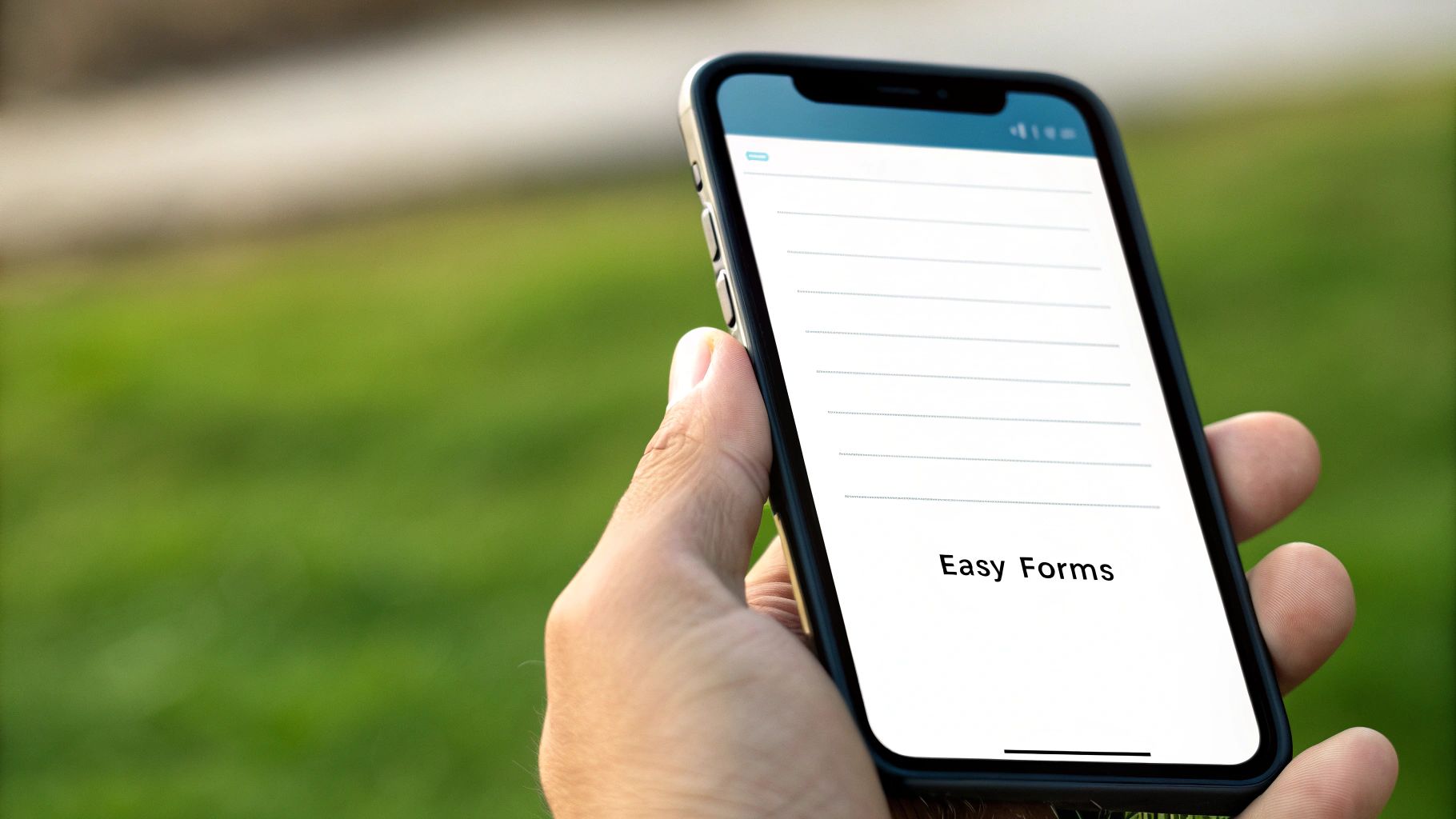
The core principle is simple: every field you ask a user to fill out is a potential reason for them to leave. By minimizing the amount of information requested and making the process intuitive, you lower the barrier to entry. This is one of the most effective conversion rate optimization tips because it targets the final, make-or-break moment in the user journey. The less work a user has to do, the more likely they are to complete the action.
How to Implement Frictionless Forms
Optimizing your forms requires a user-centric mindset. Think about what information is absolutely essential for the initial conversion and what can be collected later. Each element, from the layout to the button text, should be designed to guide the user effortlessly toward completion.
Key steps to follow:
- Audit and Eliminate: Review every field on your form. Ask yourself, "Is this information absolutely necessary right now?" Remove any non-essential fields.
- Improve Layout and Flow: Use a single-column layout, which is easier to scan and mobile-friendly. Group related fields together logically to create a natural flow.
- Provide Instant Feedback: Implement inline validation to alert users to errors as they type, rather than waiting until they hit "submit."
- Break It Down: For longer forms, use a multi-step process with a progress indicator. This makes the form seem less intimidating and provides a sense of accomplishment.
- Use Smart Features: Enable autofill capabilities and use appropriate HTML5 input types (e.g.,
type="email",type="tel") to bring up the correct mobile keyboards.
The impact of form optimization is well-documented. For example, Expedia famously increased annual profits by $12 million simply by removing one optional field: "Company Name." Similarly, Marketo saw a 34% increase in conversions by reducing their form from nine fields down to five. These examples highlight how minor reductions in friction can lead to major gains in conversions.
4. Create Compelling and Action-Oriented CTAs
The Call-to-Action (CTA) is the gateway to your conversion goal. It's the button or link that prompts users to take the next step, whether that's making a purchase, signing up for a newsletter, or booking a demo. Optimizing your CTAs involves refining their copy, design, and placement to make them irresistible to your target audience. A weak or unclear CTA can halt an otherwise perfect user journey, making it a critical focus for any conversion rate optimization tips.
Effective CTAs are more than just buttons; they are psychological triggers that combine persuasive copy with attention-grabbing design. They reduce friction by clearly communicating what happens next and reinforce the value proposition of taking that action. The goal is to move beyond generic commands like "Submit" or "Click Here" and adopt language that is specific, benefit-driven, and aligned with user intent.
How to Implement Effective CTAs
Optimizing a CTA requires a strategic blend of design, psychology, and copywriting. It’s about creating an element that stands out visually while its message resonates with the user's needs and motivations. A powerful CTA feels like a natural and helpful next step, not a pushy sales tactic.
Key steps to follow:
- Focus on Action and Value: Use strong, action-oriented verbs. Instead of "Learn More," try "Get Your Free Marketing Plan." The copy should reflect the value the user will receive.
- Use First-Person Language: Frame the action from the user’s perspective. Unbounce famously tested "Start my free 30 day trial" against "Start your free 30 day trial" and saw a 90% increase in conversions with the first-person copy.
- Optimize Design and Placement: Use a contrasting color that makes the button stand out but still fits your brand palette. Ensure it is placed logically where the user is ready to act, often "above the fold" or after a compelling value proposition.
- Create Urgency or Scarcity: When appropriate, use time-sensitive language like "Get 50% Off Today Only" to encourage immediate action.
- Test Everything: A/B test your CTA's copy, color, size, and placement. A simple color change from green to red increased conversions by 21% for one company, proving that small tweaks can yield significant results.
ContentVerve provides another powerful example, showing a 161.66% increase in clicks by changing CTA copy from "Request a Quote" to the lower-commitment "Request Pricing." These cases highlight how crucial CTA optimization is for improving your overall conversion rate.
5. Build Trust with Social Proof and Trust Signals
Social proof is a psychological phenomenon where people assume the actions of others reflect correct behavior for a given situation. In digital marketing, it means showcasing positive feedback and endorsements from existing customers to persuade new visitors. By displaying testimonials, reviews, case studies, and trust badges, you can overcome skepticism, build credibility, and provide the assurance potential customers need to make a purchase decision. This is one of the most powerful conversion rate optimization tips because it addresses a fundamental barrier: a lack of trust.
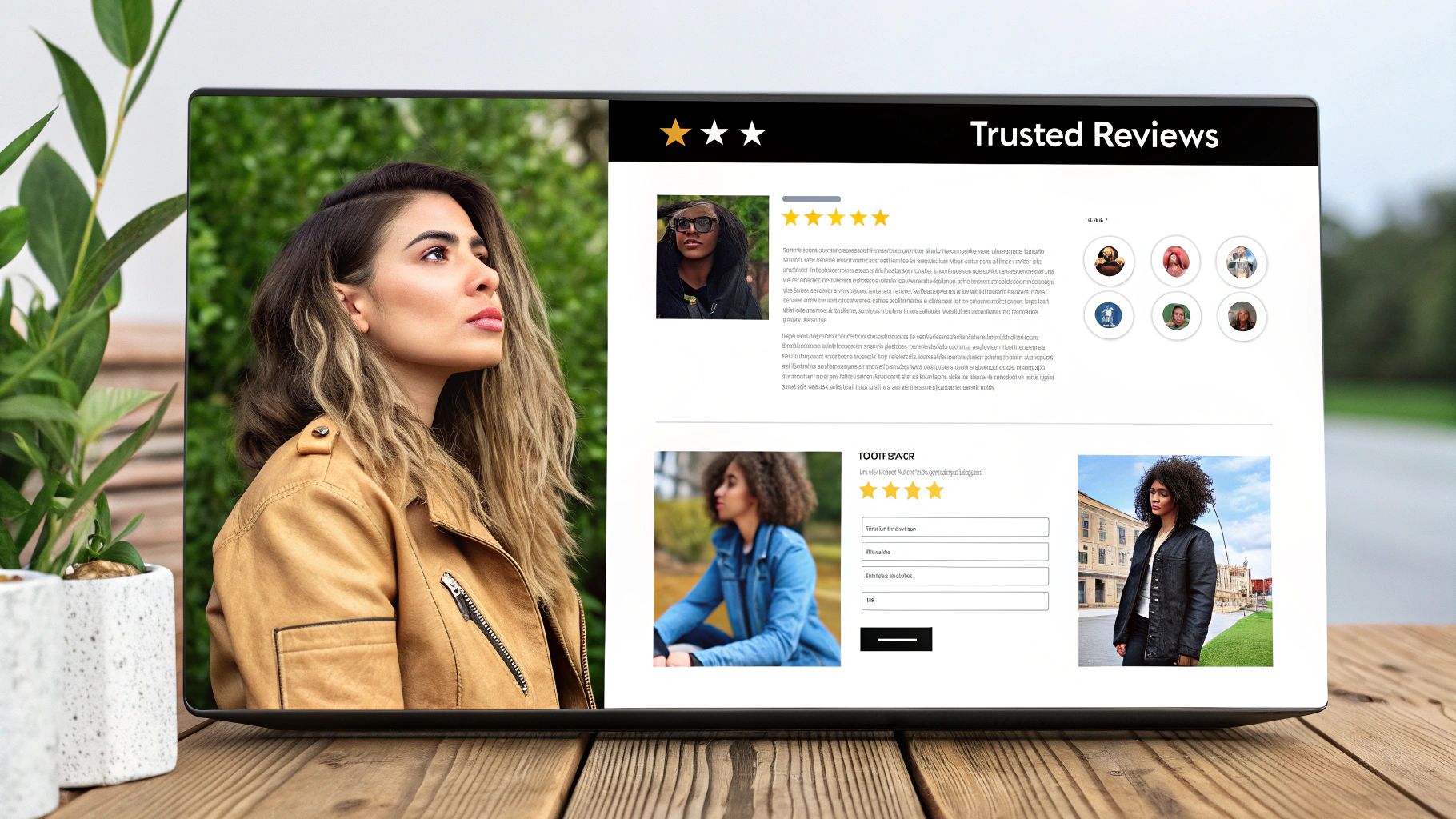
This concept, heavily influenced by the work of Robert Cialdini, taps into our natural tendency to follow the crowd. When visitors see that others have purchased your product and had a good experience, their perceived risk decreases significantly. This is especially critical for e-commerce and B2B services where decisions often involve a notable financial or operational investment. The principle is simple: if it worked for them, it will probably work for me. Learn more about Cialdini's persuasion principles on copymasters.co.
How to Implement Effective Social Proof
Successfully leveraging social proof involves more than just adding a generic testimonial to your homepage. It requires a strategic placement of authentic and relevant trust signals throughout the user journey to address specific doubts as they arise. Your goal is to make the decision to convert feel safe and validated.
Key steps to follow:
- Collect Authentic Reviews: Use platforms like Yotpo or Trustpilot to automatically solicit reviews post-purchase. Authentic, user-generated content is far more credible than curated quotes.
- Place Proof Near Conversion Points: Position your strongest testimonials, security badges (like Norton or McAfee), or customer logos directly beside CTAs, sign-up forms, and checkout buttons.
- Use Specific and Detailed Testimonials: A quote that says, "This product increased our lead generation by 45% in three months," is much more impactful than, "Great product!" Include names, photos, and company details for added authenticity.
- Showcase Quantifiable Results: For B2B, detailed case studies that outline a customer's problem, your solution, and the measurable results are incredibly persuasive. Heap Analytics famously boosted sign-ups by 60% just by adding customer logos to their homepage.
- Leverage Different Formats: Combine written reviews with video testimonials, user-generated photos, and media mentions. Video is particularly effective at conveying emotion and building a human connection.
A classic example is Amazon, which pioneered the online customer review system. Its success is heavily credited to the trust built through this transparent, user-driven social proof. Similarly, WikiJob saw a 34% increase in conversions simply by adding customer testimonials to their product pages, proving the direct impact of this strategy.
6. Optimize for Mobile Experience
Mobile optimization is the process of ensuring that visitors who access your site from smartphones and tablets have an experience customized for their device. With mobile traffic now accounting for the majority of website visits globally, a mobile-first approach is no longer optional; it's essential for survival and growth. This practice goes far beyond simple responsive design, encompassing touch-friendly navigation, faster load times, simplified forms, and streamlined checkout processes specifically for smaller screens.
A poor mobile experience creates friction, frustrates users, and directly leads to abandoned carts and lost conversions. Coined by Luke Wroblewski, the "Mobile First" approach urges designers and developers to start with the mobile experience before scaling up to desktop. This prioritizes the core user journey for the largest audience segment, making it a critical component of any modern conversion rate optimization tips collection. When users can navigate and convert effortlessly on their phones, revenue follows.
How to Implement Effective Mobile Optimization
Successful mobile optimization requires thinking about the user's context: they are often on the go, potentially with a weaker internet connection, and using their thumbs to navigate. Every element must be designed with these constraints in mind to create a seamless path to conversion.
Key steps to follow:
- Audit Your Current Experience: Use Google's Mobile-Friendly Test to get a baseline report and identify immediate technical issues.
- Prioritize Thumb-Friendly Design: Place key navigation elements and call-to-action buttons within the "thumb zone" at the bottom and center of the screen for easy one-handed access.
- Streamline Forms and Navigation: Radically reduce the number of form fields for mobile users. Use mobile-specific input types (like a numeric keypad for phone numbers) and simplify menus to only essential links.
- Boost Performance: Optimize images specifically for mobile devices to slash load times. Implement browser caching and consider technologies like Accelerated Mobile Pages (AMP) for content-heavy pages.
- Test on Real Devices: Do not rely solely on browser emulators. Test your site's functionality, layout, and speed on a variety of popular iOS and Android devices to catch real-world issues.
The results of a focused mobile strategy can be transformative. After a mobile-first redesign, Canadian e-commerce store Skinny Ties saw a 377% increase in revenue from mobile devices. This proves that investing in a dedicated, high-quality mobile experience is one of the most direct paths to significant conversion gains.
7. Implement Clear Value Propositions and Benefit-Focused Copy
A clear value proposition is the cornerstone of high-converting pages. It’s a concise statement that tells visitors why they should choose your product or service over the competition. It must instantly articulate the unique benefits and solutions you provide, answering the user's implicit question: "What's in it for me?" Without this clarity, visitors are left confused about what you offer and why it matters, leading to high bounce rates and lost opportunities. Benefit-focused copy supports this by translating features into tangible outcomes for the customer.
This bar chart visualizes key numerical frameworks used in developing and testing a clear value proposition.
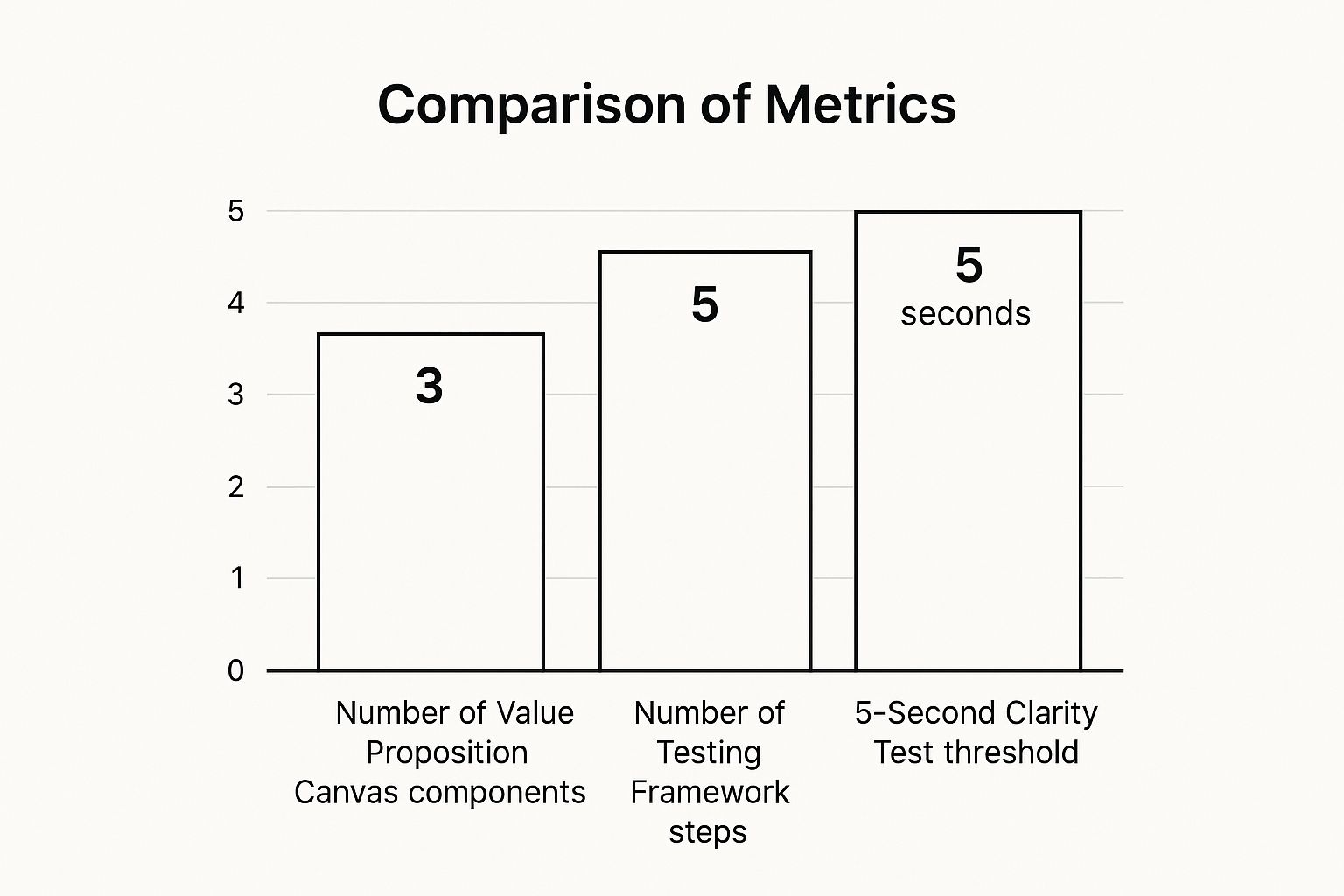
The chart highlights the core components of value proposition design and validation, including the essential 5-second test to gauge immediate clarity. By focusing on these structured approaches, you can systematically craft messaging that resonates with your audience.
How to Craft a Compelling Value Proposition
A powerful value proposition isn't just a catchy slogan; it's a strategic message built on customer understanding. It should be the first thing a visitor sees, typically "above the fold" on a homepage or landing page. For example, Slack's "Where Work Happens" immediately communicates its core purpose as a central collaboration hub, while Dollar Shave Club’s "Shave Time. Shave Money." directly addresses two major customer pain points.
Key steps to follow:
- Lead with Benefits, Not Features: Instead of saying "Our software has a 10GB cloud drive," say "Securely access all your important files from anywhere." Focus on the outcome for the user.
- Use Customer Language: Analyze customer reviews, surveys, and support tickets to understand the exact words your audience uses to describe their problems and desired solutions.
- Be Specific and Quantifiable: Where possible, use numbers to make your claims more credible. "Join 50,000+ businesses growing with us" is more powerful than "Many businesses use our tool."
- Perform the 5-Second Test: Can a new visitor understand what you offer and why it's valuable within five seconds of landing on your page? If not, your value proposition needs refinement.
- Ensure Message Consistency: The promise you make in your ads must be immediately reinforced on your landing page. This alignment builds trust and reduces friction in the user journey.
By focusing on benefit-driven language, you create a stronger connection with potential customers. This approach is fundamental not just for headlines, but for all your marketing communications, including email campaigns and product descriptions. For more guidance, you can learn more about how to write product descriptions that convert.
8. Reduce Cart Abandonment with Strategic Tactics
Cart abandonment optimization is the process of recovering sales from customers who add items to their cart but leave without completing the purchase. With the average cart abandonment rate hovering around 70%, even a small reduction can lead to a significant revenue boost. This tactic involves identifying and removing friction points in the checkout process and using targeted communication to bring shoppers back. It’s a critical focus area for e-commerce, as it directly addresses lost revenue at the final stage of the customer journey.
The primary reasons shoppers abandon carts, as identified by research from institutions like the Baymard Institute, often include unexpected costs (shipping, taxes), a mandatory account creation process, and a complicated checkout flow. By systematically addressing these barriers, you make it easier for customers to follow through on their purchase intent. This is one of the most impactful conversion rate optimization tips because it targets users who have already demonstrated a high intent to buy, making them a valuable audience to re-engage.
How to Implement Effective Cart Recovery
A successful cart recovery strategy is a combination of on-site optimization and off-site remarketing. The goal is to make the initial checkout experience as seamless as possible while having a plan to recapture those who still drop off. This requires a proactive approach to simplifying the final steps of the sales funnel.
Key steps to follow:
- Be Transparent with Costs: Display all costs, including shipping and taxes, as early as possible in the process to avoid surprises at the final step. ASOS famously reduced abandonment by 50% just by showing delivery information earlier.
- Simplify the Checkout: Reduce the number of form fields and steps required. Offering a prominent guest checkout option is crucial; Express saw a 20% conversion lift by adding this feature.
- Build Trust: Display security badges (e.g., SSL, McAfee) near payment fields to reassure customers that their information is safe.
- Offer Flexible Payments: Provide multiple payment options, including digital wallets like Apple Pay, Google Pay, and PayPal, to cater to user preferences.
- Deploy Abandoned Cart Emails: Use automation tools like Klaviyo to send a sequence of reminder emails. The first should be sent within an hour while purchase intent is still high. Include images of the abandoned items and a direct link back to the cart.
Casper's email sequence, which offers help and highlights product benefits, reportedly recovers around 15% of abandoned carts. Similarly, Frank Body uses a playful, on-brand tone in their recovery emails, achieving open rates over 35%. These examples show that a strategic and user-centric approach to checkout can directly translate into recovered revenue.
Conversion Rate Optimization Tips Comparison
| Item | Implementation Complexity 🔄 | Resource Requirements ⚡ | Expected Outcomes 📊 | Ideal Use Cases 💡 | Key Advantages ⭐ |
|---|---|---|---|---|---|
| A/B Testing and Multivariate Testing | Moderate to High (requires statistical analysis and tools) | Medium to High (traffic volume, specialized tools) | Data-driven incremental improvements in conversion | Any digital asset with sufficient traffic | Reduces guesswork, measurable ROI, continuous optimization |
| Optimize Page Load Speed | Moderate (technical expertise needed for performance tuning) | Medium (technical skills, infrastructure) | Faster load times, improved SEO, higher conversion rates | Websites targeting fast user experience & SEO | Direct impact on conversions, SEO boost, reduces costs |
| Simplify Forms and Reduce Friction | Low to Moderate (design updates, testing) | Low to Medium (UX design, form tools) | Increased form completions and conversions | Lead capture forms, checkout forms | High conversion lift with minimal changes |
| Create Compelling and Action-Oriented CTAs | Low (copywriting and design tweaks) | Low (copy and design resources) | Improved click-through and conversion rates | All digital touchpoints needing clear user actions | Quick to test, significant impact, minimal technical needs |
| Build Trust with Social Proof and Trust Signals | Low (content addition and layout changes) | Low to Medium (gathering testimonials, visuals) | Reduced purchase anxiety, higher customer confidence | E-commerce, B2B sites, new visitors | Builds credibility quickly, often inexpensive to implement |
| Optimize for Mobile Experience | Moderate to High (redesign and mobile-specific features) | Medium to High (development, testing on devices) | Better mobile conversions, improved SEO, lower bounce rates | Websites with majority or growing mobile traffic | Future-proofs site, enhances brand perception |
| Implement Clear Value Propositions and Benefit-Focused Copy | Low to Moderate (strategic messaging & design) | Low to Medium (copywriting, customer research) | Reduced bounce rates, improved qualified leads | Landing pages, marketing campaigns | Clarifies customer value, improves ad and site performance |
| Reduce Cart Abandonment with Strategic Tactics | Moderate (process changes, email automation, UX improvements) | Medium (email tools, UX design, payment integrations) | Higher recovered sales, improved checkout completions | E-commerce checkout processes | Direct revenue recovery, quick ROI, improved CX |
Start Converting: Your Path to Sustainable Growth
The journey to higher conversions is not a sprint; it's a marathon of continuous, iterative improvement. Throughout this guide, we've navigated the essential pillars of a successful conversion strategy, moving far beyond generic advice to provide a concrete, actionable blueprint. You now have a powerful toolkit filled with proven conversion rate optimization tips designed to transform your digital presence from a passive brochure into a dynamic engine for growth.
We started with the foundational discipline of A/B and multivariate testing, the scientific method of the digital marketer. This isn't just about changing button colors; it's about developing a deep, data-backed understanding of what truly motivates your audience to act. This empirical approach is the thread that connects all other optimizations, ensuring your decisions are driven by evidence, not assumptions.
From there, we addressed the critical, non-negotiable elements of user experience. We highlighted the direct correlation between page load speed and conversion rates, reinforcing that in the digital world, every millisecond counts. We also tackled the friction-filled landscape of online forms, demonstrating how simplification and strategic design can dramatically reduce user drop-off at the most crucial stages of the funnel.
Turning Insight into Action
The core of persuasion lies in clear communication and compelling direction. That's why we dedicated focus to crafting action-oriented CTAs and formulating crystal-clear value propositions. Your user must understand, in an instant, what you offer, why it matters to them, and what they need to do next. Vague promises and confusing calls-to-action are conversion killers.
Simultaneously, we explored the psychological levers that build confidence and drive decisions. Implementing social proof and trust signals, from customer testimonials to security badges, is not merely a design choice; it’s a strategic move to dismantle user skepticism. In an era of digital noise, trust is your most valuable currency. This trust is further cultivated by delivering a seamless mobile-first experience, acknowledging that a significant portion of your audience interacts with you from the palm of their hand. Ignoring this is akin to closing your doors to half of your potential customers.
Finally, we tackled one of the most persistent challenges in e-commerce and lead generation: cart and form abandonment. The strategies discussed, from exit-intent pop-ups to transparent pricing, are designed to recapture wavering interest and guide users across the finish line.
Your Path Forward: From Theory to Implementation
Mastering these concepts is about adopting a new mindset, one rooted in empathy for the user and a relentless pursuit of clarity. It’s about viewing your website not as a static entity, but as a living ecosystem that can be continually refined and optimized. The true value of these conversion rate optimization tips lies in their consistent and systematic application.
Your immediate next step is to conduct a user journey audit. Identify the single biggest point of friction on your site. Is it a slow-loading landing page? A confusing checkout process? An unclear value proposition?
Choose one area to focus on first. Apply the relevant principles from this article and formulate a hypothesis. Then, test it. Measure the results, learn from the data, and repeat the process. This cycle of hypothesizing, testing, and iterating is the engine of sustainable growth. By committing to this process, you’re not just tweaking a website; you're building a more efficient, profitable, and user-centric business.
Crafting compelling, benefit-focused copy is the foundation for almost every tip discussed, from your CTAs to your value propositions. If you need expert help turning your data-driven insights into persuasive content that converts, Copy Masters specializes in creating high-quality, search-optimized articles and web copy. Visit Copy Masters to see how our professional writers can help you implement these strategies and accelerate your growth.
- SaaS SEO Consulting for Predictable Growth - October 20, 2025
- What Is SEO Management Your Guide to Real Results - October 19, 2025
- A Guide to Quality Content for SEO That Ranks - October 18, 2025
